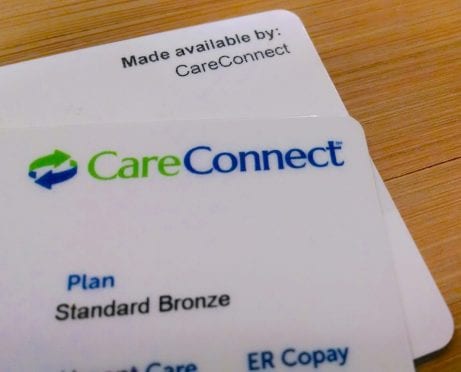
When I was laid off from my job at the beginning of this year, I knew I was luckier than most people in a similar predicament. Although I'd been at the job for just under a year, I received severance for the next three months. Plus, I kept my health benefits for four more. But how was I going to deal with the lost health insurance coverage once that time ran out?
I was also in the middle of planning my wedding at the time. So instead of treating that severance period like an extended vacation, I started freelancing my butt off right away to save myself some financial stress down the road.
Once that last day of health benefits rolled around, I still wasn't sure what to do.
COBRA was way too expensive, and picking a plan from the health insurance marketplace through the Affordable Care Act (or “Obamacare”) wasn’t the best solution for me right then, either.
Plus, I would have the option to get on my soon-to-be husband’s insurance less than five months later. But what would I do in the meantime? As it turns out, I had plenty of options to help cover the gap left by my lost health insurance coverage:
- Download a “telehealth” app.
- Choose generic medications over brand-name prescription drugs.
- Hunt down discounts and coupons.
- Visit a low-cost clinic.
1. “Telehealth” Apps
Whether or not you’ve got insurance, “telehealth” apps are a cost-effective alternative to an in-person doctor’s visit when you might not be able to afford one. Using an app like Doctor On Demand, you can communicate with a board-certified, fully credentialed physician via video chat for about $40.
If needed, you can even get a prescription for nonemergency medical issues like a cold, the flu, or allergy symptoms.
2. Generic vs. Brand-Name
This one seems as if it should be obvious. You probably have no problem with buying generic ibuprofen over the counter, right? Any doctor will quickly confirm that generic and brand-name drugs are virtually the same.
But it can be easy to overlook this factor when you don’t have both options right in front of you. As such, make sure to ask if there’s a generic option — especially if your prescribed medicine costs more than you expected.
3. Discounts and Coupons
If you lose health insurance coverage, don’t just assume that you’ll no longer be able to afford your medicine. GoodRx allows you to type in the name of your drug by brand or generic name, compare prices at local pharmacies, and print coupons to help you save up to 80 percent on the retail cost of your medications.
There are other places you can go to for coupons, as well. For example, although I had dental insurance for a good four months after my layoff, my next exam and cleaning wouldn’t be covered unless it was six months or more after my previous one.
That just so happened to be two weeks after my benefits ended. Talk about unfortunate timing. Having noticed options in the past, I turned to Groupon, where I found a deal for an exam, cleaning, and X-rays for $35.
4. Low-Cost Clinics
One reason I decided against a marketplace health plan for now is that I’m lucky to be in excellent health (knock on wood!) and didn’t need a single doctor visit in that four-month period in which I was unemployed, but still insured.
It’s that likely all I will need this year is my well-woman and physical exam. With a quick call to Planned Parenthood, I found out that locally, these checkups would only cost me about $150 out-of-pocket.
That Groupon dental visit came in handy. I learned I had an old filling that needed to be replaced. The dentist quoted me a “discounted” cost of $240 for the procedure without insurance. Talk about expensive!
But if I waited more than a couple of months to take care of it, I could end up needing a more painful (and more expensive) root canal. So I immediately started shopping around.
Through FreeDentalCare, I found Central Care Integrated Services, a sliding-scale clinic where the cost of a service is based on your income. I won’t lie: It was definitely a pain to arrive at the beginning of walk-in hours (it’s not uncommon for these clinic appointments to be booked up for months) and wait two hours for the staff to process my freelance pay stubs before actually starting my visit.
But it was ultimately worth it to save more than $100. And the peace of mind was a huge bonus.









